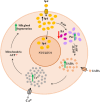Enhanced γ-aminobutyric acid levels promote degeneration of silk glands following spermidine supplementation in Bombyx mori
- PMID: 40514595
- PMCID: PMC12166014
- DOI: 10.1007/s00726-025-03462-5
Enhanced γ-aminobutyric acid levels promote degeneration of silk glands following spermidine supplementation in Bombyx mori
Abstract
Silk glands are modified labial glands that produce silk which has immense commercial importance. Silk is extruded out in liquid form after which the glands undergo autophagy and apoptosis during larval to pupal transition. Biogenic amines, specially spermidine and γ-aminobutyric acid (GABA) are known to play an important role in autophagy. Yet, GABA is not identified in the silk glands till now and therefore its role in autophagy remains unknown. Current study aimed to evaluate role of biogenic amines in the autophagy of silk glands. Fifth instar silkworms were fed with control and spermidine supplemented mulberry leaves under controlled conditions. Qualitative and quantitative analysis of biogenic amines were analyzed in silk glands of control and spermidine fed groups at the end of feeding stage, spinning and pre-pupal stages. Biogenic amines were significantly decreased in the silk glands from feeding stage to non-feeding prepupal stages. Elevated levels of biogenic amines; putrescine, spermidine, and spermine were observed in silk glands at pre-pupal stage in the spermidine fed group. The unknown biogenic amine whose levels were significantly elevated during silk gland degeneration in both control and spermidine fed groups was identified as GABA by spectroscopic techniques. This is the first report of the identification of GABA in the silk glands of Bombyx mori which increased significantly following spermidine supplementation, resulting in elevated levels of calcium deposits, contributing to the early degeneration of the silk glands.
Keywords: Bombyx mori; Autophagy; Biogenic amines; Calcium; GABA; Silk glands; Spermidine.
© 2025. The Author(s).
Conflict of interest statement
Declarations. Conflict of interest: The authors declare no competing interests.
Figures





Similar articles
-
Spermidine enhances the silk production by mulberry silkworm.J Insect Sci. 2014 Jan 1;14:207. doi: 10.1093/jisesa/ieu069. Print 2014. J Insect Sci. 2014. PMID: 25502041 Free PMC article.
-
Functional analysis of 30K proteins during silk gland degeneration by a caspase-dependent pathway in Bombyx.Insect Mol Biol. 2013 Jun;22(3):273-83. doi: 10.1111/imb.12019. Epub 2013 Mar 18. Insect Mol Biol. 2013. PMID: 23496335
-
Morphological changes and patterns of ecdysone receptor B1 immunolocalization in the anterior silk gland undergoing programmed cell death in the silkworm, Bombyx mori.Acta Histochem. 2009;111(1):25-34. doi: 10.1016/j.acthis.2008.02.001. Epub 2008 Jun 12. Acta Histochem. 2009. PMID: 18554690
-
The effect of bovine milk on the growth of Bombyx mori.J Insect Sci. 2013;13:98. doi: 10.1673/031.013.9801. J Insect Sci. 2013. PMID: 24205942 Free PMC article.
-
The advances and perspectives of recombinant protein production in the silk gland of silkworm Bombyx mori.Transgenic Res. 2014 Oct;23(5):697-706. doi: 10.1007/s11248-014-9826-8. Epub 2014 Aug 12. Transgenic Res. 2014. PMID: 25113390 Review.
References
-
- Aparna Y, Surekha C, Satyavathi VV, Anitha M (2016) Spermidine alleviates oxidative stress in silk glands of Bombyx mori. J Asia-Pac Entomol 19:1197–1202
-
- Bootman MD, Chehab T, Bultynck G, Parys JB, Rietdorf K (2018) The regulation of autophagy by calcium signals: Do we have a consensus? Cell Calcium 70:32–46. 10.1016/j.ceca.2017.08.005 - PubMed
-
- Eisenberg T, Knauer H, Schauer A, Büttner S, Ruckenstuhl C, Carmona-Gutierrez D, Ring J, Schroeder S, Magnes C, Antonacci L, Fussi H, Deszcz L, Hartl R, Schraml E, Criollo A, Megalou E, Weiskopf D, Laun P, Heeren G, Breitenbach M, Grubeck-Loebenstein B, Herker E, Fahrenkrog B, Fröhlich K-U, Sinner F, Tavernarakis N, Minois N, Kroemer G, Madeo F (2009) Induction of autophagy by spermidine promotes longevity. Nat Cell Biol 11:1305–1314. 10.1038/ncb1975 - PubMed
MeSH terms
Substances
LinkOut - more resources
Full Text Sources

